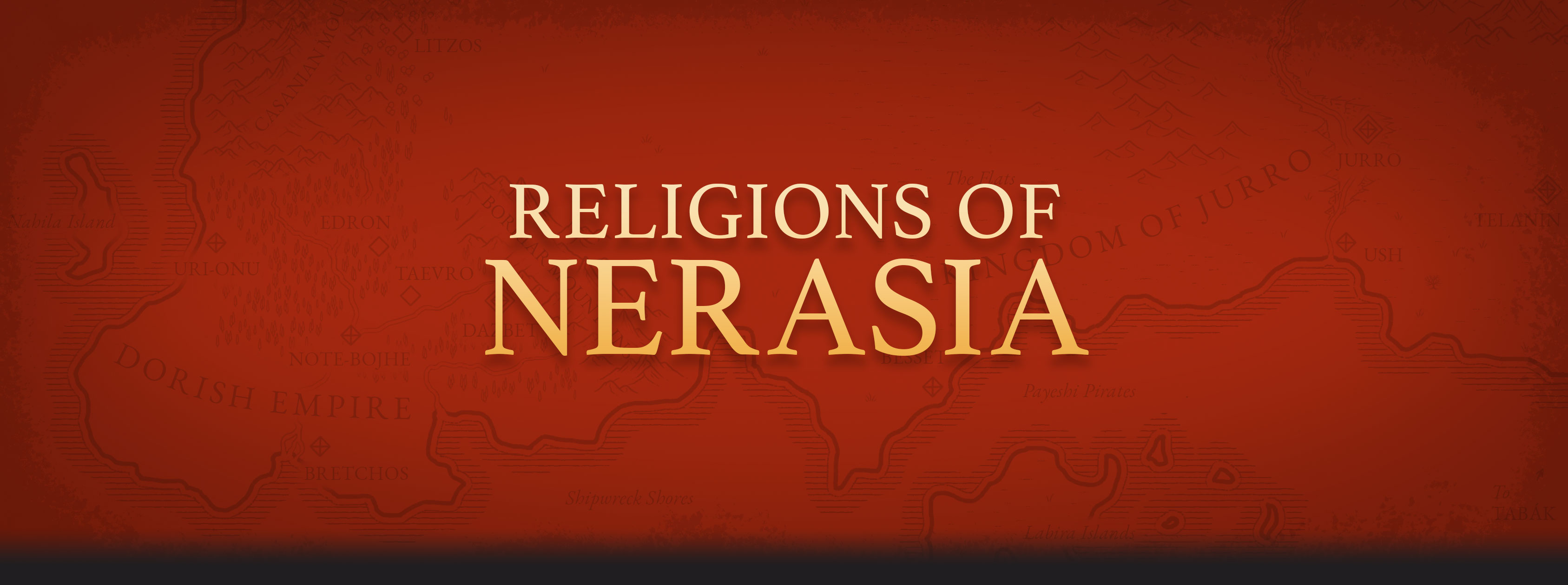Religions of Nerasia: Overview
There are a number of religious systems in the world of Nerasia. What follows is an overview of them all.
Pavratha
Pavratha is the oldest organized religion in Nerasia. It is practiced primarily by the civilizations of the Majria Mountains, but is also practiced in some other places, such as Asík and parts of the Ikani Forest. Followers of Pavratha (also known as Pavrathians) believe that the gods created mankind in another land across the sea, and that the gods will return one day to bring about an age of eternal life and freedom from pain and misery. Ritualistic human sacrifices, carried out one per city at certain times of the year, are necessary for this beautiful future to come to pass. There are two Pavrathian temples, in Arroth and Kirihan, where keepers guard the "god stones," relics of an age when gods walked among humans. These stones are very powerful, and can be used in emergencies to defend Pavratha from enemies to the faith. The religion is matrilineal and matriarchal, characterized by queens and priestesses and holy spaces where males may not enter. But Pavrathians believe that one day, at the returning of the gods, knowledge and equality will come for all.Eastern shamanism
Throughout the regions of Kahr and Urrum, an unorganized shamanistic religion is common. Local religious leaders with healing abilities use a sacred plant to attain spiritual experiences. In time, during the Kingdom Age, some of these shamanistic practices evolve into something more organized. Several religious orders are formed, which are both highly exclusive and somewhat secretive. The peoples of Kahr and Urrum share many mythological stories and deities with southern polytheists. Different deities are favored by various cities and populations. In Sray, a beloved myth, The Epic of Ishara, tells an origin story of humanity that begins across the sea, much like the Pavrathian belief. The telling of this story, however, differs greatly from that of the Pavrathians.Southern polytheism
Multiple deities are worshipped and shared among the regions of Kahr, Urrum, the Jothal Desert, and the nomads of the Westfields and Midlands. While some cities, tribes, and households may favor one such deity over another, all are recognized as equally legitimate. It is not uncommon for a southern Nerasian to worship as many of these gods as possible, to attain the best odds of a successful life. In Jurro, the winged rulers of the city are also considered gods, and cannot be gazed upon without permission and ritualistic cleansing. Among the nomads of the Westfields and Midlands, the planet Ekra is the most important god worthy of devotion.Mashendian mythology and religion
The Mashendians of northern Nerasia follow a semi-organized religion. This religion is polytheistic, with exactly seven gods are are seen as having important, dependent relationships with each other. At its core, the Mashendian religion centers around the concept of balance. The cosmos, or ultimate reality, is dependent on balance; without it, everything will fall into ruin and chaos. Mashendian culture has strong attitudes of gender equality as an outgrowth of these "balance" mindsets. Unlike Pavrathians and Srayans, Mashendians believe that the continent of Nerasia is where humans originated. The world existed before animals and humans; both the world and the gods, in fact, are eternal. There was a time when only animals lived on the earth, and after a while, the gods added humans to the mix. There are a couple notable subdivisions of the Mashendian religion. The first is that of the Akkium and Bantakal city-states, who believe that Aberrants (notable, people with bat wings, claws, and night vision) reflect an imbalance in the universe. Aberrants are thus hunted, and their bodies used in ritual. This practice followed the Dorins, a band of Bantakalians, down into Karoa with the formation of their Dorish Empire. The second subdivision is that of the Asikians, cousins to the Mashendians. The nation of Asík converted to Pavratha long ago, and practices a hybrid of both religions, with mythology borrowed from both traditions.Isama
The three major people groups of Karoa — that is, the Mosori, Sabani, and Ilisi — all practice variations of a religion called Isama. The word Isama refers to spiritual health, and the practices that foster it. Isama is a mystical and meditative tradition, with monasterial orders, a focus on spirits, and a belief in mysterious gods with secretive names. Within the Isama tradition exists two major subdivisions. It is these subdivisions that separate Mosori tribes from Sabani tribes, more so than any particular ethnic differentiations. The city of Ilies practices a version of the Mosori tradition, with some minor differences.Remove these ads. Join the Worldbuilders Guild









Comments